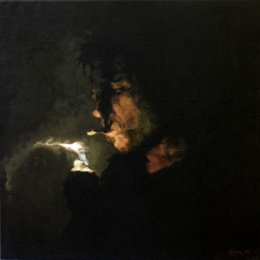art or business
Gábor Kapusi: Solo/nely collection
Gábor Kapusi (1960) pursued his studies at the Hungarian University of Art and Design in the second half of the 80s. Although he has participated in a number of exhibitions with his graphics, computer prints and photos, in recent years, we he has been known primarily for his graphic and corporate design work. In his solo exhibition at the kArton Gallery, entitled “Solo/nely Collection”, he presents his paintings from the past three years. As the pertinent play on words may suggest, the scenes, seemingly familiar to many of us, are icons of a “collection of states of mind” unraveling from a sensitive and personal visual world. It would be difficult to mention specific trends and movements in painting in conjunction with the pieces, although we encounter a number of precisely painted art historical reminiscences (landscape, portrait, natura morta).
Nevertheless, the film and musical references, as suggested by the individual scenes – mise en scenes – are what create the final “layer”, the sometimes dark, bizarre, and magical general effect. Gábor Kapusi wraps the dreamlike transience suggested by his images into icon-like permanence. His object of investigation is the anatomy of drama. A strange ambiance surrounds the “public exhibition” of loneliness, whose törzsét gist can be read as a collection of archetypal visual correspondents to well-known psychic states. It may be likened to the feeling we get when we have a premonition of danger and, in believing that we are escaping it, we are headed straight toward it. It is an unidentified and buzzing anxiety, like the kind that overcomes us when watching a David Lyncs film (ex: “Blue Velvet”, “Mulholland Drive”. Every one of Lynch’s films is a “symphony of angst”, someone once wrote. Gábor Kapusi, by delineating the dream images or unconscious feelings, which served as his points of departure, has created unique musical scores of angst and loneliness.
A bilingual catalogue is under preparation for Gábor Kapusi’s exhibition, featuring writings by József Mélyi, Gábor Németh and Bálint Solymosi.

